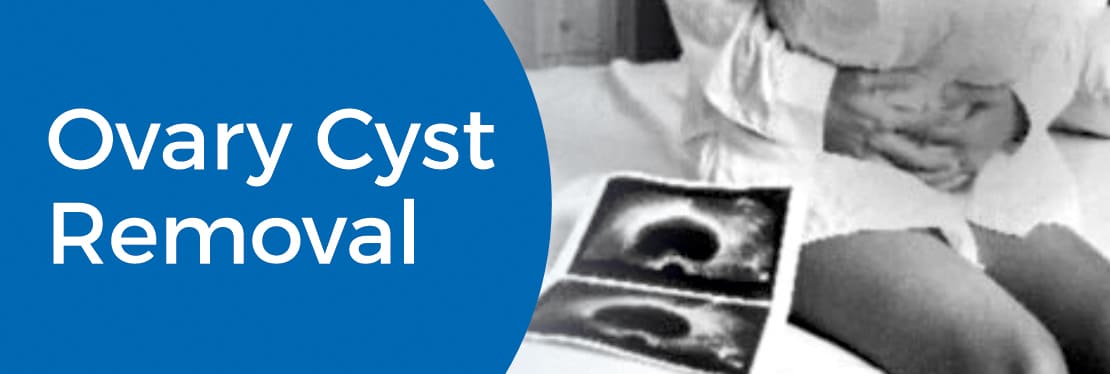Overview
During a woman’s menstrual cycle, an egg grows in a sac called a follicle. This sac is located inside the ovaries. In most cases, this follicle or sac breaks open and releases an egg. But if the follicle doesn’t break open, the fluid inside the follicle can form a cyst on or inside the ovary.Solid or fluid-filled sac or pocket (cyst) within or on the surface of an ovary is called as ovarian cyst.
Ovarian cysts usually disappear in a few months but can cause complications if they don’t. Most ovarian cysts don’t cause symptoms. In some cases, menstrual irregularities, pain during intercourse or irregular bowel movements can occur.
Many cysts go away on their own. If not, treatments like contraceptive pills or surgery are available.
Types of Ovarian Cysts:
There are two main types of ovarian cysts:
- Functional Ovarian Cysts: These are cysts that develop as part of the menstrual cycle. They are the most common type and are usually harmless and short lived.
- Pathological Ovarian Cysts: These are much less common and form as a result of abnormal cell growth.
A vast number of ovarian cysts are usually non cancerous although some can be cancerous. Post menopausal cysts can quite often be cancerous. Cysts can also be formed due to endometriosis.
Symptoms of an ovarian cyst
A person with an ovarian cyst usually only shows symptoms if it ruptures, is very large, or blocks the blood supply to the ovaries.
In these cases, you may have:
- Pelvic pain – this can range from a dull, heavy sensation to a sudden, severe and sharp pain
- Pain during sex
- Difficulty emptying your bowels
- A frequent need to urinate
- Heavy periods, irregular periods or lighter periods than normal
- Bloating and a swollen tummy
- Feeling very full after only eating a little
- Difficulty getting pregnant – although fertility is usually unaffected by ovarian cysts
Why it’s Done
Whether treatment is needed will depend on:
- Its size and appearance
- Whether you have any symptoms
- Whether you’ve had the menopause – if you are postmenopausal there is a slightly higher risk of ovarian cancer
What can you expect?
There are 2 types of surgery used to remove ovarian cysts:
- A laparoscopy
- A laparotomy
These are usually carried out under general anaesthesia.
Laparoscopy:
Most cysts can be removed using laparoscopy. This is a type of keyhole surgery where small cuts are made in the tummy and gas is blown into the pelvis to allow the surgeon to access your ovaries.
A laparoscope (a small, tube-shaped microscope with a light on the end) is passed into your abdomen so the surgeon can see your internal organs. The surgeon then removes the cyst through the small cuts in your skin.
After the cyst has been removed, the cuts will be closed using dissolvable stitches.
Laparotomy:
If your cyst is particularly large, or there’s a chance it could be cancerous, a laparotomy may be recommended.
During a laparotomy, a single, larger cut is made in the tummy to give the surgeon better access to the cyst.
The whole cyst and ovary may be removed and sent to a laboratory to check whether it’s cancerous. Stitches or staples will be used to close the incision.
The procedure may take up to 1-2 hours. You may need to stay in hospital for a few days possibly 2-3 days after the procedure. You will have abdominal pain and discomfort for 7-10 days and will be given some pain medication.
Results/Post Procedure
The time it takes to recover from surgery is different for everyone. After the ovarian cyst has been removed, you’ll feel pain in your tummy, although this should improve in a few days. After a laparotomy, it may take as long as 4-6 weeks before you can resume normal activities.
If the cyst is sent for histopathology testing, the results will come in a week and the doctor will discuss with you whether you need any further treatment.
Ovarian cysts do not usually prevent you getting pregnant, although they can sometimes make it harder to conceive. If you need to undergo surgery to remove your cysts, the surgeon will aim to preserve your fertility as much as possible. This may mean removing just the cyst and leaving the ovarian tissue intact, or only removing 1 ovary. In some cases, surgery to remove both your ovaries may be necessary, in which case you’ll no longer produce any eggs and will need to opt for a donor egg program or surrogacy.
What Are the Risks?
Complications are rare, but no surgical interventional procedure is completely free of risk.
- Infection
- Bleeding
- Cyst returns after removal
- Need for removal of 1 or both ovaries
- Infertility
- Blood clots
- Damage to other organs
Factors that may increase the risk of complications include:
- Obesity
- Chronic or recent illness
- Heavy use of alcohol, smoking , or use of narcotics (may make delivering anaesthesia more difficult or impair wound healing)
- Use of certain prescription medications
- Pregnancy
- Previous abdominal surgery
